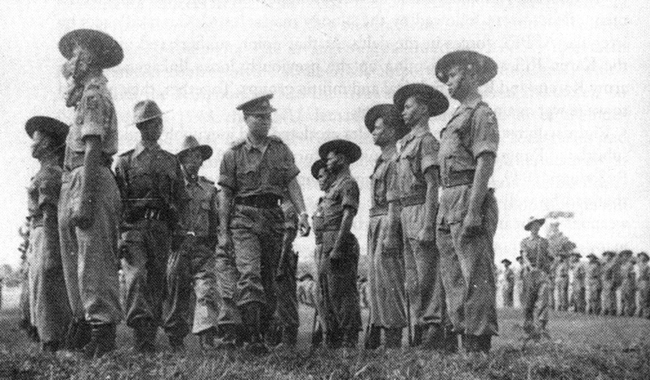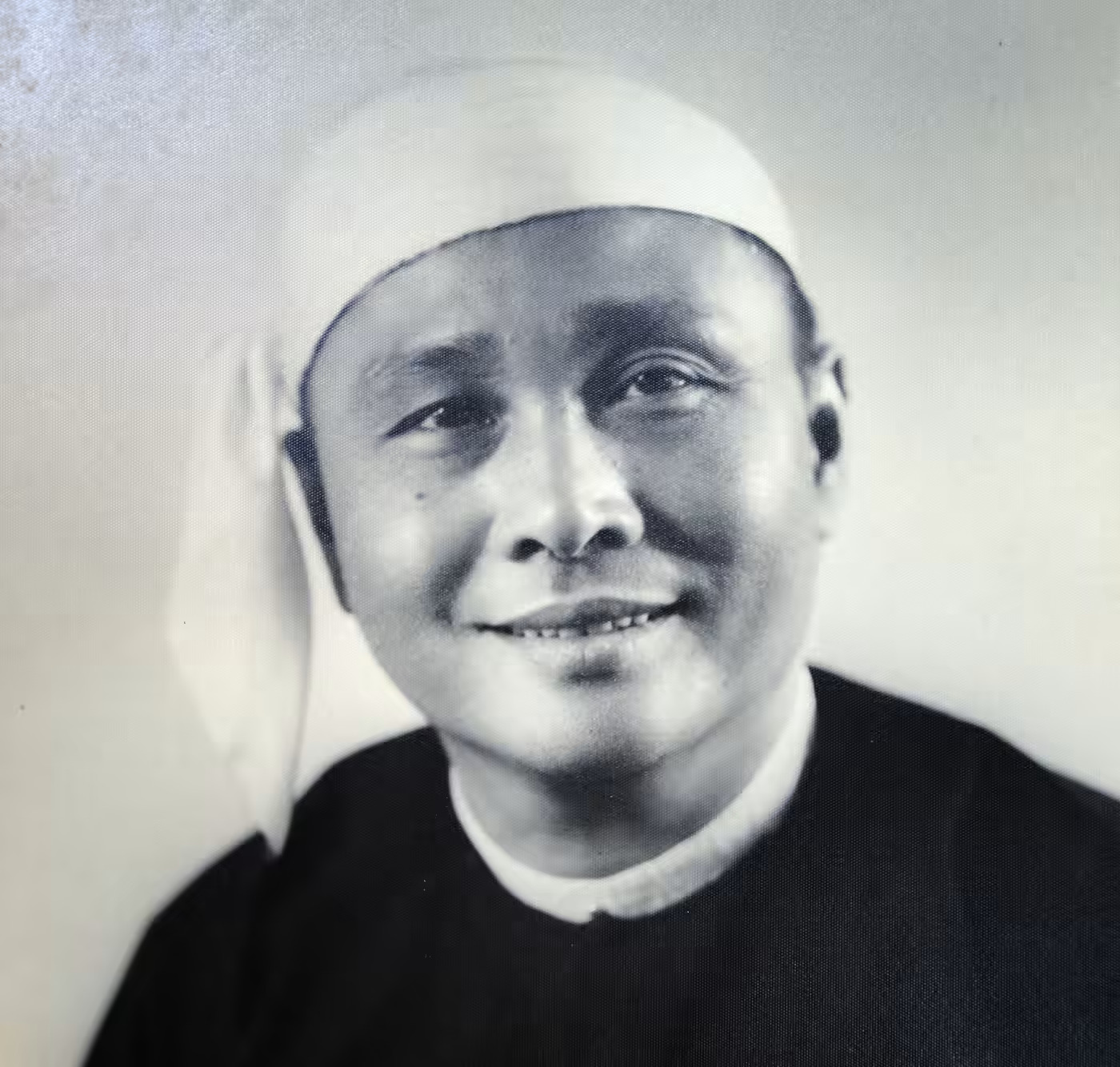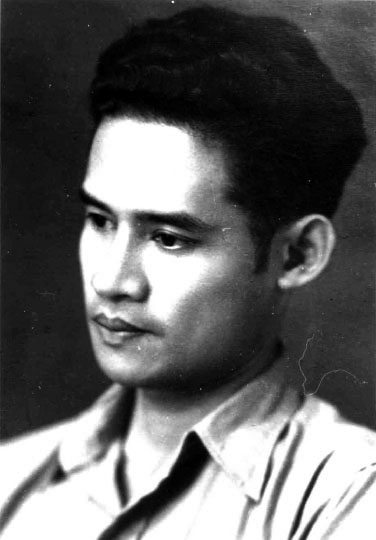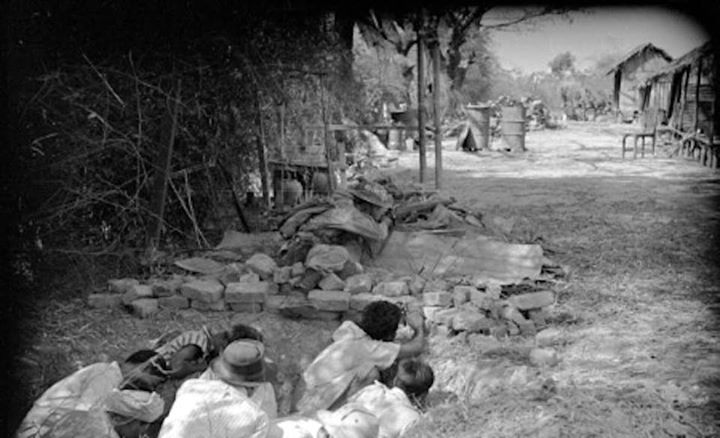

U Nu, First Prime Minister of Independent Burma

Bo Htun Lin of PVO, Thakin Than Tun and Thakin Soe

Lieutenant General Smith Dun

Major General Ne Win

Saw Ba U Gyi, Leader of KNU

Civilians trapped between battles
January 1948
Longest on-going civil war
people U Nu General Aung San General Ne Win
The Burmese civil war is the longest-running armed conflict in the world and has continued, in one form or another, from independence to the present day. In a way Burma is a place where World War Two never really stopped. Ever since the first Japanese bombers hummed overhead and dropped their payloads over downtown Rangoon, the country has not known peace. For a brief period, between August 1945 and independence in January 1948, there were no open hostilities. And since then, there have been times, when fighting is sporadic, with small encounters here and there, affecting only isolated areas. But the gun has never been taken away from Burmese politics. And no government has governed the entirety of Burma since 1941. There has not been a succession of wars; rather the same war, the same rhetoric, and sometimes even the same old rifles have staggered on and on, with only minor changes to the cast and plot and a few new special effects. Some of the very same groups that first took up arms in the 1940s, when Mahatma Gandhi was languishing in a British jail and Joe Louis was heavyweight champion of the world, are still in conflict today.
When U Nu, the first Prime Minister of independent Burma, took over the reins of government from the last British Governor Sir Hubert Rance (who went on to a cushier job as governor of Trinidad), the country was already saddled with two active, if minor, insurgencies. The first was the revolt of the so-called Red Flag Communists, hard-liner Stalinists, loyal to their firebrand ex-schoolmaster party chairman, Thakin Soe. The other was the Mujahideen Islamic insurgency in the north of Arakan. A much bigger problem than either was the huge militia, called the People’s Volunteer Organization, made up of demobilized former soldiers of the Burma Independence Army, once loyal to Aung San and the cause of independence and, since the death of Aung San without clear aims or leadership. The country was awash in weapons and full of young men who had never held proper jobs. A generation had grown up watching the armies of Imperial Japan, the British Empire, China, and the United States battling it out in their own backyard and could imagine nothing more exciting than soldiering. And this was the generation that was coming of age.
The next to revolt was the Communist Party of Burma under its leader, Thakin Than Tun. It was the most formidable of the government’s foes; popular, well-armed, and with the possibility of foreign backing. The Communists argued that the Anti-Fascist People’s Freedom League had become little more than a tool of British imperialism and that it was therefore necessary to overthrow it and establish a proper people’s government. This was the thesis crafted by H.N. Goshal, the party’s chief dogmatist, and was formally adopted by the Central Council a month after the British departure. Strikes were organized, and violence was stirred up. Last-minute attempts at compromise went nowhere. The militia groups, the various Communist factions, and the government considered and then rejected a peaceful solution. Prime Minister U Nu offered to stand down.
Within just two months of Burma's independence, Than Tun called for a people's revolution and ordered his twenty thousand or so armed men to begin their campaign. Within weeks, up and down the Irrawaddy Valley, one town after another fell to the Communists. In April, Communist units seized police stations, took over town centers, looted rice warehouses, and cut telephone and telegraph lines. The government fought back, and after a few weeks it looked as if the worst might be over. At this point U Nu tried to make yet another offer of reconciliation and announced his own “Leftist Unity” programme. It called for state control of much of the economy and society, and for a new league that would be devoted to Marxist doctrine and would be made up of Communists as well as Socialists. British and American journalists and intelligence analysts wrote that Burma was on the verge of being handed over lock, stock, and barrel to Than Tun and his puppet masters in the Kremlin.
As an increasingly humid heat gave way to welcome showers, parts of the regular army itself began to peel away from Rangoon’s authority. At that time, the Burma Army amounted only to around fifteen thousand men, organized into ten frontline battalions. Half the army was comprised of heavily politicized, ethnic Burmese battalions, often left-leaning or at least radical and full of derring-do. One of these battalions, the Sixth Burma Rifles, mutinied at Pegu on 16 June, and many of its officers and men immediately joined up with the Communists. The worst was yet to come.
In July, the entire People’s Volunteer Organization, the umbrella for various militia groups, also went into revolt. Then two more army battalions mutinied: the First Burma Rifles at Thayetmyo and the Third Burma Rifles at the Mingaladon Air Base just outside the capital. Both were headed by former lieutenants of General Aung San. They attempted to link up and march on Rangoon but their convoys were only just stopped by the Burma Air Force, led by the Anglo-Shan wing commander Tommy Clift. Then it was the turn of the Union Military Police, which declared itself on no side in particular but in opposition to the government all the same, taking reams of cash from government treasuries as well as arms and ammunition. Half the country was now in the hands of one rebel faction or another. Trains and steamers stopped running. In places, a state of emergency was declared. Rumours circulated: some said Indian troops had landed or that the British Fourteenth Army would soon be back. What was to come was no less fantastic.
Up until this time the government was depending heavily on the support of the six battalions of Karen and Kachin Rifles inherited from the British Burma Army. These troops had helped retake the strategic town of Prome halfway up the Irrawaddy as well as Thayetmyo and the Pyinmana area in the first of what were to be 50 years of counter insurgency operations. The commander-in-chief at the time was Lieutenant General Smith Dun, an ethnic Karen who was purportedly named after Jimmy Stewart’s character in Mr. Smith Goes to Washington. His deputy and the head of the army was Major General Ne Win.
For a while things seemed to be going in the right direction. In December the Communists were routed in a few targeted operations and driven from their Pyinmana headquarters. Three thousand other Communists surrendered at Toungoo. All of this was the work of loyal Karen and Kachin fighters, including Kachin units under the command of the dashing captain Naw Seng, a much-decorated anti-Japanese war hero.
Naturally enough, some of the Karen fighters began wondering whether they were doing the right thing in propping up the government and whether they shouldn’t instead be thinking more of taking advantage of the situation and pushing their own demands. Some wanted to set up an independent Karen state in the east of the country.
Around this time Moulmein, the third-largest city, was taken over by disgruntled Karens from the military police. More Karen rebellions seemed imminent. Some leaders in the Karen community, including San Po Thin, a former Ringling Bros. and Barnum & Bailey Circus performer, tried to negotiate some sort of deal with Rangoon. Moulmein was eventually handed back, and a new commission to look at autonomy issues was set up. It was a good and representative commission, but there were many, on both sides, who wanted no compromise. There were Burmese who hated the Karens and Karens who thought all-out independence was within their grasp – “like Laos”, some said. British troublemakers egged them on, and at least two former members of Force 136, the wartime British Special Forces group, were caught smuggling arms into the country and expelled. The Karen National Union began building up its military wing, the Karen National Defense Organization (KNDO). Rangoon responded by hastily raising thousands of extra militiamen to defend the capital.
On Christmas Eve 1948, Burmese government soldiers massacred at least eight Karen civilians in the eight different churches in and around the palm-shaded beach town of Mergui. A little later a Karen village north of Rangoon was attacked by police under the command of a leading Burmese politician. Over 150 Karens were killed, 30 shot down in cold blood. The KNDO then raided the armoury at Insein (next to Rangoon), and the Fourth Burma Rifles (an ethnic Burmese battalion) burned to the ground the American Baptist Mission school at Maubin. In villages around the delta, neighbors suddenly turned on one another. Karen pastors preached the need to lead their people from the hands of the unbelievers. The KNDO attacked the port city of Bassein (Pathein) only to be driven out after two days of heavy fighting. On 31 January, clashes broke out on the outskirts of Rangoon itself.
The next day General Smith Dun, the loyal Karen head of the armed forces, was replaced by Japanese-groomed Major General (now General) Ne Win, a Burmese. Karen neighborhoods in the west of Rangoon were set on fire by angry mobs, and Karen civilians gunned down as they tried to escape from their homes. Just to the north of the city the KNDO seized the suburb of Insein as well as the sizable armoury at Mingaladon. Incensed at what was happening to their kinsmen, three Karen battalions, arguably the best-trained third of the army, then went into full rebellion. If they had acted quickly, they might have combined forces and easily taken the capital. The U Nu government would have collapsed, and the whole history of post-war Burma would have been different. But they hesitated; they were angry, but they had no plan. Some of their units came within a few miles of the city center but did not break through the main government positions.
On the other side, the hero of the day was General Ne Win, whose Fourth Burma Rifles, together with military police and some quickly raised Gurkha and Anglo-Burmese militiamen, were able to hold the line. Two of the Karen battalions came down the main roads leading to Rangoon but were held up near Tharrawaddy and then strafed by the blue and red-striped government Spitfires. A sort of front line emerged just outside Rangoon, and both sides set about digging in.
If that weren’t enough, government workers went on a general strike in protest against recent pay cuts. By mid-February all government offices were shut down, and civil administration everywhere ground to a halt. Rangoon itself was paralyzed by mass demonstrations, and an assortment of armed groups began parading up and down city streets, calling for the overthrow of U Nu. Then, to top it off, and suspiciously just before exam month, the students went on strike.
Through all this, Parliament continued to meet and even passed a few new laws. And for those looking for a fun time, the cinemas remained open, as well as the racetracks at the Rangoon Turf Club, where General Ne Win could be seen every weekend despite sounds of artillery not far away. For a few rupees it was even possible to ride a special bus to the front line and take a few pot shots at the Karen soldiers lurking in the distance.
Elsewhere in the country, things were not looking good either. The Kachin commander Naw Seng raised his own flag of revolt, declared that his First Kachin Rifles were now in an alliance with the rebel Karens, and quickly overran a succession of towns in the hilly areas from Pyinmana to Maymyo. On 13 March, despite a fierce defense by local militia, Mandalay fell to the rebel side. At Pakokku, to the west of the Irrawaddy, the commanding officer of an ethnic Chin battalion, having received no orders for a while, came to the reasonable conclusion that all government had come to an end and simply marched his men back home to the hills.
It was an incredibly confusing picture. In some places the Communists shared power with militia leaders whereas Mandalay came under the joint rule of the Karen and the Communist Party. In other places, various strongmen with no particular affiliations emerged at the head of armed groups to take over administration. Few had clear aims, and those that did had no desire to compromise. The lesson of World War Two and Aung San’s campaign against the British seemed to be that stubbornness, coupled with as much force as possible, was the best way to get ahead. All the young men clung to their separate visions of a perfect Burma, and were determined to soldier on.
It was from this ignominious beginning that the Burmese military machine of today was built up, almost from scratch. The combined strength of all the anti-government forces was estimated at around thirty thousand troops, and these were good troops, including whole battalions trained by the British. Against this, General Ne Win had a paltry three thousand regular soldiers from some loyal companies, mainly men of his own Fourth Burma Rifles who had served under him and Aung San during the war and who included many trained by the Japanese. From the scrap heaps left behind by General Slim’s Fourteenth Army, Ne Win was able to cobble together two tanks.
But, as the specter of anarchy or a communist takeover loomed large, valuable help came from the British, who supplied arms and ammunition as well as six Dakota airplanes that allowed the government side to maintain contact with disparate parts of the country and ferry troops around as necessary. These were flown by British pilots on civilian contracts. Ne Win’s men were also helped by Catalina flying boats, flown by American war veterans as well as by Burmese airmen; easy-to-land planes that could wreak havoc on enemy troop concentrations with their nifty side machine guns. Even the prime minister flew around in a Catalina (piloted by an American pilot, Captain Chet Brown) to rally his people. Britain also lent six million pounds to the beleaguered government, and Britain, together with Australia, India, Ceylon, and the United States, gave another eight million dollars in emergency aid. As British, Indian, and other ambassadors tried to facilitate talks, there was speculation that Burma, after a little more than a year away, might even re-join the Commonwealth.
In April, a column of two thousand troops led by the renegade Kachin commander Naw Seng moved south in Willis jeeps and worn-out trucks with the hope of taking Rangoon by 1 May, but was stopped less than a hundred miles from the capital. It was the last major attempt of its kind, and the tide soon began to turn in earnest. Mandalay was re-taken after ferocious fighting, and the civil service strike collapsed. The Karens were defeated in a series of clashes around Rangoon and then driven across the river toward the onetime Portuguese settlement at Syriam. A few weeks later their stronghold at Toungoo was taken, and their leader, the former schoolteacher Saw Ba U Gyi, was assassinated in a Burmese army ambush. The Communists looked expectantly toward help from China and, in the early months of the Korean War, repositioned many of their forces up to Katha in the hope of linking up with Chinese forces in a new Pacific war. But Ne Win was able to move from strength to strength, and a spirited army operation soon overran the Communist headquarters (“the Sunflower Camp”), splintering the People’s Army into less threatening guerrilla bands.
After this cascade of government good fortune, the communists and the Karens were divided on what to do next. Some pushed for terms with the government. It was not quite over, but slowly - town by town, village by village - the Burma Army began to assert its authority.
For the young republic, it had been a disastrous start and on top of all the destruction of World War Two, the recent fighting had cost the country an estimated 250 million pounds (more than 9 billion U.S. dollars, in today’s money) in material damage. There were two men who had pulled the country back from the brink and had averted a communist takeover or an all-out disintegration of the country: Prime Minister U Nu and the armed forces Commander-in-Chief General Ne Win. Together, and in entirely different ways, they would shape the Burma of the next half century.
~ Adapted from The River of Lost Footsteps by Thant Myint-U